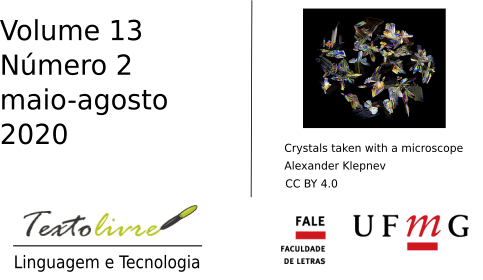Sing and learn
análise da recepção de uma ferramenta virtual de ensino de línguas
DOI:
https://doi.org/10.35699/1983-3652.2020.24389Palavras-chave:
Sing and learn, CALL, Estratégias de aprendizagemResumo
As tecnologias digitais da informação e comunicação estão presentes em nosso cotidiano a todo instante, influenciando também os processos de ensino-aprendizagem de língua estrangeira ao fornecer material autêntico e audiência real aos aprendizes. A ferramenta virtual Sing and Learn é um website de estudo de língua inglesa a partir de letras de músicas, ferramenta que não apenas proporciona exercícios de compreensão oral, como também oferece práticas de vocabulário, gramática, leitura e escrita, de maneira a instigar os alunos a se valer de diferentes estratégias de aprendizagem (MORAES, 2017). O presente trabalho busca, então, analisar uma lição realizada no Sing and Learn a partir do conceito de estratégias de aprendizagem (OXFORD, 1990; 2003), bem como será investigada a recepção de estudantes universitários diante da ferramenta citada. Para tanto, os dados da pesquisa foram obtidos através de um questionário virtual aplicado com alunos de uma disciplina de Inglês Instrumental após realizarem a lição. Como método de análise dos dados, foi construída, a partir de Saldaña (2012), uma classificação através de códigos para as respostas dadas pelos alunos às perguntas dissertativas propostas no questionário. Os resultados do estudo mostram uma aceitação da ferramenta por parte dos aprendizes, verificando que ela tem muito a contribuir para o ensino-aprendizagem de língua inglesa.
Downloads
Referências
BECK, R. J. What Are Learning Objects? Center for International Education. 2001. Disponível em: http://www4.uwm.edu/cie/learning_objects.cfm?gid=56. Acesso em: 23 nov. 2019.
BERNARD, H. R. Research Methods in Anthropology: Qualitative and Quantitative Approaches. Fifth Edition. New York: Altamira Press, 2011.
BOOTHE, D.; WEST, J. English Language Learning through Music and Song Lyrics – The Performance of a Lifetime. International Conference: The Future of Education, Edition 8. 2018. p. 1-5. Disponível em: https://conference.pixel-online.net/FOE/files/foe/ed0005/FP/0475-ITL949-FP-FOE5.pdf. Acesso em: 23. nov. 2019.
BRAGA, J. de C. F.; SILVA, L. de O.; JUNIOR, R. C. G. CALL & MALL: using technology to achieve educational objectives in the language classroom. In: OLIVEIRA, A. L. A. M.; BRAGA J. de C. F. (org.). Inspiring insights from an English Teaching Scenes. Belo Horizonte: CEI – Curso de Especialização em Ensino de Inglês FALE/UFMG, 2017. p. 121-141.
COSTA, E. S. da. Sing and Learn: Sistema de ensino de inglês através de músicas. 2018. (Trabalho de Conclusão de Curso em Sistemas de Informação) - Universidade Luterana do Brasil, Canoas, 2018.
BUTLER-PASCOE, M. E.; WIBURG, K. M. Technology and teaching English language learners. Boston: Pearson Education, 2003.
ELLIS, R. Task-based Language Learning and Teaching. New York: Oxford University Press, 2003.
ENGH, D. Why Use Music in English Language Learning? A Survey of the Literature. English Language Teaching, v. 6, n. 2, p. 113-127, 2013.
FARDO, M. L. A gamificação aplicada em ambientes de aprendizagem. Novas Tecnologias na Educação-CINTED-UFRGS, Porto Alegre, v. 11, n. 1, p. 1-9, jul. 2013.
GARRET, N. Computer-Assisted Language Learning Trends and Issues Revisited: Integrating Innovation. The Modern Language Journal, v. 93, p. 719-740, 2009.
GRIFFITHS, C.; CANSIZ, G. Language learning strategies: An holistic view. Studies in Second Language Learning and Teaching, v. 5, n. 3, 2015. p. 473-493.
HODGINS, H. W. The future of learning objects. e-Technologies in Engineering Education: learning outcomes providing future possibilities. In: LOHMANN, J.; CORRADINI, M. (eds.). ECI Symposium Series. v. P01, 2002. p. 76-82. Disponível em: https://dc.engconfintl.org/etechnologies/11/. Acesso em: 23 nov. 2019.
HUBBARD, P. Mini-course: An Invitation to CALL. Foundations of Computer-Assisted Language Learning. Unit 1: Introduction to Computer-Assisted Language Learning. Linguistics Department – Stanford University. 2016. Disponível em: https://web.stanford.edu/~efs/callcourse2/CALL1.htm. Acesso em: 23 nov. 2019.
LANKSHEAR, C.; KNOBEL, M. Sample ‘the new’ in New Literacies. In: LANKSHEAR, C.; KNOBEL, M. (org.). A New Literacies Sampler. New York: Peter Lang Publishing, 2007, v. 29. p. 1-24.
LYRICSGAPS. Lyrics gaps. Disponível em: https://www.lyricsgaps.com/. Acesso em: 02 mar. 2020.
LYRICSTRAINING. Lyrics training. Disponível em: https://lyricstraining.com/. Acesso em: 02 mar. 2020.
MARTINS, C. B. M. J.; MOREIRA, H. O campo CALL (Computer Assisted Language Learning): definições, escopo e abrangência. Calidoscópio, Vol. 10, n. 3, p. 247-255, set/dez 2012.
MORAES, M. de M. Working with songs beyond listening practice – The creation of a language learning tool. 2017 (Trabalho de Conclusão de Curso de Licenciatura em Letras) – Universidade Federal do Rio Grande do Sul, Porto Alegre, 2017.
MORETI, A; ALONSO, M. Dealing with Songs through the Four Skills. Revista Científica de Letras. Franca, São Paulo. v. 5, n. 5, p. 85-112, 2009.
MURPHEY, T. Music and Song. Oxford. 1992a.
MURPHEY, T. The Discourse of Pop Songs. TESOL Quarterly, v.26, n.4. p.770-774, 1992b.
OXFORD, R. L. Language Learning Strategies: What Every Teacher Should Know. USA: Heinle & Heinle Publishers, 1990.
OXFORD, R. L. Language Learning Styles and Strategies: an Overview. Learning Styles & Strategies. Oxford: Gala, p. 1-25, 2003.
ROJO, R. Between Platforms ODAs and Prototypes: New multiliteracies in WEB2 times. The ESPecialist: Descrição, Ensino e Aprendizagem, v. 38, n. 1, p. 1-20, 2017.
SALDAÑA, J. The coding manual for qualitative researchers 2nd ed. Thousand Oaks, CA: Sage, 2012.
SINGANDLEARN. Sing and Learn. Disponível em: http://www.singandlearn.com.br/. Acesso em: 02 mar. 2020.
VILAÇA, M. L. C. Classificação de Estratégia de Aprendizagem de Línguas: Critérios, Abordagens e Contrapontos. Revista Eletrônica do Instituto de Humanidades. n. 36, p. 43- 56, 2011.
WARSCHAUER, M.; HEALEY, D. Computers and Language Learning: an overview. State of the art article, United Kingdom, p. 57-71, 1998. Disponível em: http://hstrik.ruhosting.nl/wordpress/wp-content/uploads/2013/03/Warschauer-Healey-1998.pdf. Acesso em: 23 nov. 2019.
WILEY, D. A. Connecting learning objects to instructional design theory: a definition, a metaphor, and a taxonomy. In: WILEY, D. A. (Ed.). The instructional use of learning objects: Online Version. 2002. Disponível em: https://pdfs.semanticscholar.org/03fe/e95ed98d8dc262ccd363a589a235db91e331.pdf?_ga=2.176406821.1805027650.1586484294-1431907872.1586484294. Acesso em: 10 mar. 2019.
Publicado
Edição
Seção
Licença

Este trabalho está licenciado sob uma licença Creative Commons Attribution 4.0 International License.
Este é um artigo em acesso aberto que permite o uso irrestrito, a distribuição e reprodução em qualquer meio desde que o artigo original seja devidamente citado.











